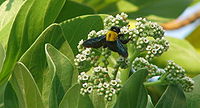- Heliotropium foertherianum
-
Heliotropium foertherianum 
In the Hawaiian Islands Conservation status Scientific classification Kingdom: Plantae (unranked): Angiosperms (unranked): Eudicots (unranked): Asterids Order: Lamiales Family: Boraginaceae Genus: Heliotropium Species: H. foertherianum Binomial name Heliotropium foertherianum
Diane & HilgerSynonyms Tournefortia argentea L.f.
Argusia argentea (L.f.) Heine
Messerschmidia argentea (L.f.) I.M.Johnst.
Tournefortia arborea BlancoHeliotropium foertherianum is a species of flowering plant in the borage family, Boraginaceae. It is native to tropical Asia, including southern China, Madagascar, northern Australia, and most of the atolls and high islands of Micronesia and Polynesia. Common names include Tree Heliotrope, Velvet Soldierbush and Octopus Bush. It is a shrub or small tree typical of littoral zones reaching a height of 6 m (20 ft), with a similar spread.
Contents
Taxonomy
Originally published as Tournefortia argentea, it was transferred to Argusia argentea, and remained under that name until recently. It was subsequently restored to Tournefortia before being transferred into Heliotropium under a new name in 2003.[2][3]
Uses
Wood
The wood of H. foertherianum is commonly used to make handicrafts, tools, and, in Polynesia, frames for swim goggles. Due to its availability, H. foertherianum is used as firewood, and has become rare in some areas as a result.[4]
Medicinal
Octopus bush is used in many Pacific islands as a traditional medicine to treat ciguatera fish poisoning, which is caused by powerful ciguatoxins produced by microscopic Gambierdiscus algae. Scientists from the Institute of Research for Development (IRD) and the Louis Malarde Institute in French Polynesia and Pasteur Institute in New Caledonia are researching the plant chemistry and believe that the plant possesses a molecule similar to rosmarinic acid, which is known for its antiviral, antibacterial, antioxidant and anti-inflammatory properties.[5] The researchers think rosmarinic acid may remove the ciguatoxins from their sites of action, as well as being an anti-inflammatory.
References
- ^ World Conservation Monitoring Centre 1998. Argusia argentea. 2006 IUCN Red List of Threatened Species. Downloaded on 20 August 2007.
- ^ IngentaConnect A systematic analysis of Heliotropiaceae (Boraginales) based on t
- ^ "Heliotropium foertherianum Diane & Hilger". Australian Plant Name Index (APNI), IBIS database. Centre for Plant Biodiversity Research, Australian Government. http://www.anbg.gov.au/cgi-bin/apni?taxon_id=266155.
- ^ Elevitch, Craig R.; Harley I. Manner (April 2006) (PDF). Tournefortia argentea (tree heliotrope). The Traditional Tree Initiative. http://www.agroforestry.net/tti/Tournefortia-treeheliotr.pdf.
- ^ Ilano, Theresa V. (2010-06-09). "Antidote to fish toxin isolated from local plant". SciDev.Net. http://www.scidev.net/en/news/antidote-to-fish-toxin-isolated-from-local-plant.html.
External links
 Media related to Heliotropium foertherianum at Wikimedia Commons
Media related to Heliotropium foertherianum at Wikimedia Commons  Data related to Tournefortia argentea at WikispeciesCategories:
Data related to Tournefortia argentea at WikispeciesCategories:- IUCN Red List least concern species
- Heliotropium
- Flora of Ashmore and Cartier Islands
- Flora of the Coral Sea Islands Territory
- Flora of the Northern Territory
- Flora of Queensland
- Eudicots of Western Australia
- Lamiales of Australia
- Naturalized trees of Hawaii
- Least concern flora of Australia
- Least concern biota of Queensland
- Trees of Australia
- Flora of the Tubuai Islands
- Trees of the Pacific
- Flora of Christmas Island
- Lamiales stubs
- Australian asterid stubs
- Tree stubs
Wikimedia Foundation. 2010.


